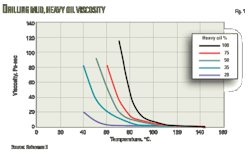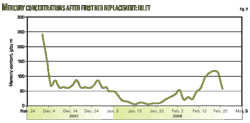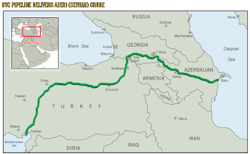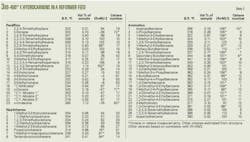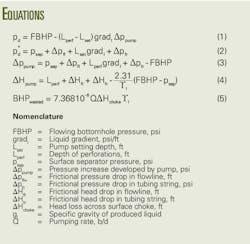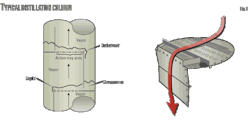The US working drilling rig count has started to reverse its steep drop as expectations for crude and gas prices and demand have become more bullish.
The Baker Hughes Inc. US rig count for the week ending Oct. 23 was 1,048, up 8 rigs from the previous week. Although this is down considerably from the 2,031 rigs working in September 2008, the count was up 172 rigs from the 2009 low point of 876 rigs in June.
Recent oil prices have been above $70/bbl since reaching a low of about $32/bbl in December 2008 (Fig. 1). Spot gas prices at the Henry Hub have remained below $4/MMbtu, although gas future prices and the large MMbtu spread between oil and gas prices seem to indicate that gas prices will rise (Fig. 2).
Fig. 3 shows the fall in the Baker Hughes working rig count in the world from a high of 3,557 rigs in October 2008 to a low of 1,983 rigs in June 2009 and an increase to 2,203 working rigs in September 2009.
In its world rig count, Baker Hughes does not include land rigs drilling in China and Russian as well as activity in Iran, Iraq, Kuwait, Sudan, and elsewhere.
Smith International shows some rig counts unavailable in the Baker Hughes statistics. For some countries, the two counts are very different. This article mainly uses the Baker Hughes rigs counts although it also presents some Smith International numbers. The Smith International rig count of total rigs operating worldwide for September 2009 of 3,444 is considerably more than the 2,203 in the Baker Hughes statistics.
The Baker Hughes count outside of the US and Canada was 986 for September, up 39 from August but down 22 from September 2008. The number of working rigs outside the US and Canada shows much less variance than the rig count for the US and Canada (Fig. 4).
Each week, the OGJ Industry Scoreboard (for example, OGJ, Oct. 26, 2009, p. 6) includes a graph showing the last 2 years of the Baker Hughes working rig count for total world, total onshore, and total offshore rigs. Also shown is a graph that compares the working rig count for the last 3 months with the rig count in the previous year for activity in the US and Canada.
Another feature in each OGJ is the weekly Baker Hughes rig count table for the US and Canada that is in the Statistics section (for example, OGJ, Oct. 26, 2009, p. 59). The table breaks out the US count by state and offshore and includes total rigs drilling for gas or oil, as well as a comparison of the activity for the same week in the previous year.
The Statistics section each week also contains a table with the weekly Smith International US rig count broken out by proposed depth.
US drilling
The US is the country with the most rigs running. Of the 1,048 in operation during the week ending Oct. 26, Baker Hughes lists 312 drilling for oil, 725 drilling for gas, and 11 drilling miscellaneous wells. A year ago, the breakdown was 423 oil, 1,529 gas, and 12 miscellaneous.
Regarding the type of drilling, Baker Hughes lists 179 rigs drilling directional wells, down 202 from last year; 472 rigs drilling horizontal wells, down 171 from last year; and 397 rigs drilling vertical wells, down 543 from last year.
Fig. 5 shows the rig activity in various basins in the US. Five main basins are seeing an increase in working rigs. The western gulf for the week ending Oct. 2 has 127 rigs working compared to low of 93 in for the week ending June 5. Other comparisons for the working rig count ending Oct. 2 with recent lows are: Permian with 146 rigs (Oct. 2) up from 76 rigs (May 15), Louisiana-Mississippi salt basin with 112 rigs (Oct. 2) up from 81 (Mar. 27), Appalachian basin with 102 rigs (Oct. 2) up from 71 (May 1), and Williston basin with 51 rigs (Oct. 2) up from 34 (May 22). For the remaining basins the aggregate count of 486 working rigs (Oct. 2) is still at a low point.
Other trends also show a pickup in activity. Pritchard Capital Partners LLC in an Oct. 12 industry update said that horizontal well permits for drilling in the Marcellus shale in Pennsylvania have soared to 184 in September, compared with 91 in August. It notes much activity in seven counties: Bradford County (36 horizontal permits), Tioga (31), Washington (23), Clinton, (15), Lycoming (14), Greene (14), Lackawanna (11), and Susquehanna (6).
It indicated that environment issues might have decreased the permit applications in Susquehanna County from the 13 in August.
Pritchard said that the most active companies in September based on horizontal permits recieved were Fortuna Energy Inc. (26), Anadarko Petroleum Corp. (25), Range Resources Corp. (24), Chesapeake Energy Corp. (19), EXCO Resources Inc. (11), and Ultra Petroleum Corp (8).
Pritchard noted that three operators in 2009 have permitted more than 95 horizontal wells in the Marcellus play. These are Fortuna (99), Chesapeake (178), and Range Resources (120).
Table 1 shows the 100 operators of record with the most wells spud in the US during January-September 2009. The table from RigData lists operator of record not parent companies. The aggregation of the subsidiary spuds would change a parent company's rank in the table. For instance, the table shows 809 wells spud by Chesapeake Operating Inc. (No. 1 in the table) and 84 wells spud by Chesapeake Appalachia LLC (No. 32).
Southwestern Energy Co. units included in the list are SEECO Inc. (No. 6) with 347 wells spud and Southwestern Energy Production Co. (No. 82) with 26 wells spud.
Of the major companies, BP PLC has two subsidiaries listed: BP America Production Co. (No. 9) with 265 wells spud and BP Exploration (Alaska) Inc. (No. 22) with 99 wells spud.
Another major, ConocoPhillips, has three subsidiaries listed: Conoco Phillips Co. (No. 10) with 234 wells spud, Burlington Resources Oil & Gas Co. LP (No. 12) with 185 wells spud, and ConocoPhillips Alaska Inc. (No. 52) with 47 wells spud.
Royal Dutch Shell PLC has two units listed: Swepi LP (No. 26) with 95 wells spud and Shell Western E&P (No. 67) with 32 wells spud.
Anadarko Petroleum Corp. (No. 84) spud 25 wells while its units Kerr-McGee Oil & Gas Onshore LP (No. 4) spud 379 wells and Anadarko E&P Co. LP (No. 24) spud 98 wells
Several other companies have more than one subsidiaries listed.
The total wells spud from January to September for the 100 operators of record is 9,469 compared with 14,277 for all operators of record.
Table 2 shows that the 2009 active drilling rig fleet for the top 25 drilling contractors in the US has increased to 2,050 rigs compared with 1,849 rigs in 2008, although working rigs have declined from 1,213 in January to 757 in September. The list includes some well servicing rigs. Nabors Drilling USA LP operator has the most active land rigs with 332. Precision Drilling Oil Field Svcs. Corp. had the largest increase in its rig fleet from the previous year because of its purchase of Grey Wolf Drilling Co. LP.
Canada
The number of oil and gas wells expected to be drilled in Canada this year is 8,787, almost a 50% decline from the 16,000 completed in 2008, according to the Canadian Association of Oilwell Drilling Contractors.
The decline is partly attributed to Alberta's new resource royalty framework that came into effect in January 2009, although since then Alberta has put in place some incentive programs for reducing oil and gas royalties for small and midsize producers to spur drilling of wells that otherwise would be uneconomical.
Most drilling in Canada is the western provinces of Alberta, British Columbia, and Saskatchewan. Because of drilling rules, Western Canadian drilling usually peaks in February and declines in the summer months before starting to climb again.
In 2009, the low point was 70 working rigs in May compared with the 2008 low point of 120 working rigs in April (Fig. 6).
Outside US, Canada
Outside of the US and Canada the working rig count in September was 986 up from 947 in August according to Baker Hughes. In September and August 2008, the rig counts were 1,087 and 1,108. By area, the rig count was 355 Latin America, 83 Europe, 57 Africa, 245 Middle East, and 246 Asia-Pacific (Fig. 7).
In Latin America, countries with the most rigs running in September were Argentina with 39 (21 oil, 18 gas), Brazil with 63 (57 oil, 6 gas), Colombia with 27 (all oil), Mexico 127 (120 oil, 25 gas), and Venezuela 56 (51 oil, 5 gas). The September 2009 working rig count in Mexico is much higher than the September 2008 rig count of 99 (72 oil and 27).
Much of Mexico's new rig activity is in the Chicontepec oil region that contains low permeability reservoirs. Media reports have said that Petroleos Mexicanos (Pemex) is reviewing performance in the region but is not suspending work there (OGJ Online, Oct. 9, 2009).
In coming years, the working rig count will pick up in Brazil as Petroleo Brasileiro SA (Petrobras) begins receiving the 28 new offshore drilling rigs it plans to have built (OGJ Online, Oct. 9, 2009) for use in the ultradeep subsalt horizons in the Santos basin off Brazil. It expects the rigs to start becoming available in 2013-17.
In the Middle East, countries with the most rigs running in September were Abu Dhabi with 12 (all oil), Oman with 46 (39 oil, 7 gas), Pakistan 20 (3 oil, 17 gas), Saudi Arabia 65 (40 oil, 25 gas), and Syria 24 (all oil).
For the same area, Smith International reports Kuwait with 31 rigs, Iran with 65 rigs (54 land, 11 offshore) and Abu Dhabi with 30 (18 land, 12 offshore). Baker Hughes count does not include the activity in Kuwait and Iran and the working land rigs in Abu Dhabi.
Countries with the highest rig count in the Asia-Pacific region were India with 94 (79 oil, 15 gas), Indonesia with 58 (37 oil, 18 gas, 3 miscellaneous), Malaysia with 17 (16 oil, 1 gas), and offshore China with 21 (20 oil, 1 gas).
Baker Hughes does not report land rigs in China, but for September Smith International counts China with 41 (7 land, 34 offshore).
Norway and the UK are the two European countries with the most working rigs included in Baker Hughes's statistics. These show Norway with 22 (20 oil, 2 gas) and the UK with 19 (13 oil, 6 gas).
Smith International has a breakout of the Russia and Caspian region. The countries with the main active rigs in this region are Azerbaijan with 13 (1 land, 12 offshore), Kazakhstan with 64 (60 land, 4 offshore), Russia with 312 (307 land, 5 offshore), and Turkmenistan with 9 (6 land, 3 offshore).
In Africa the countries with the most active rigs according to Baker Hughes are Algeria with 25 (21 oil, 4 gas), Angola with 4 (all oil), Libya with 14 (all oil), and Nigeria with 6 (all oil).
Smith International shows a rig count of 311 in Africa for September 2009 compared with the 57 in the Baker Hughes statistics. Countries with the most active rigs in the Smith International count are Algeria with 101 (all land), Angola 16 (2 land, 14 offshore), Congo 14 (6 land, 8 offshore), Egypt 56 (44 land, 12 offshore) Libya 49 (45 land, 4 offshore), Nigeria 23 (11 land, 12 offshore), and Sudan 20 (all land).
More Oil & Gas Journal Current Issue Articles
More Oil & Gas Journal Archives Issue Articles


